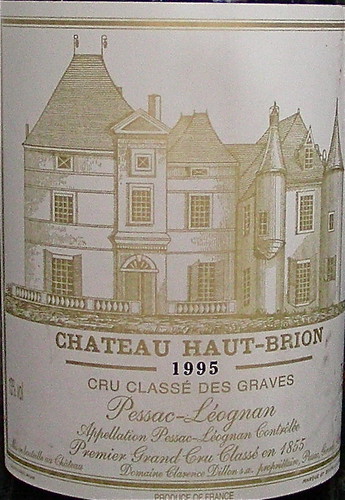 The bottle was a 1995 Château Haut-Brion, stored in our friend's wine cabinet in Chicago, patiently waiting for our visit.
The bottle was a 1995 Château Haut-Brion, stored in our friend's wine cabinet in Chicago, patiently waiting for our visit.We arrived in Chicago on a Thursday night and it was decided that we would taste the wine the following evening. As the wine was from a great vintage and highly rated, we were expecting a memorable moment.
“This wine has been brilliant on every occasion I have tasted it”, said Parker on the 1995. “More accessible and forward than the 1996, it possesses a saturated ruby/purple color, as well as a beautiful, knock-out set of aromatics, consisting of black fruits, vanillin, spice, and wood-fire smoke. Multidimensional and rich, with layers of ripe fruit, and beautifully integrated tannin and acidity, this medium to full-bodied wine is a graceful, seamless, exceptional Haut-Brion that should drink surprisingly well young.”
But as soon as we popped the cork, the bad news jumped at our nose: the wine was corked! We took a small sip to confirm the verdict and it was unmistakably bad. Sad, sad, sad!
But then I remembered a New York Times article that suggested a way to rescue a corked wine:
Mr. Waterhouse said that the obnoxious, dank flavor of a “corked” wine, which usually renders it unusable even in cooking, can be removed by pouring the wine into a bowl with a sheet of plastic wrap.
“It's kind of messy, but very effective in just a few minutes,” he said. The culprit molecule in infected corks, 2,4,6-trichloroanisole, is chemically similar to polyethylene and sticks to the plastic.
The experiment was worth trying, what could we lose? We took a large bowl, lined it with plastic wrap, and poured a small amount of the wine into the bowl. Then, after 5 minutes or so, we compared the wine from the bowl with the wine from the bottle. You could definitively detect some differences between the two. The bad chemical taste was somewhat smoothed out in the wine from the bowl, but sadly, it didn't make the wine more drinkable. Maybe the plastic wrap was able to catch some of the molecules but not all of them. And maybe we should try that experiment again but only with a wine that is marginally flawed.
Technorati tags: wine food & drink
3 comments:
Despite what I'm reading on Wikipedia in the 'Cork Taint' article, common chemistry sense says that the more surface area of plastic wrap available, the more 2,4,6 TCA would be removed. Thus, while lining a bowl with plastic wrap would work somewhat, the better method would be to cut a lot more plastic wrap into strips, and stir it in the affected wine.
Pity about the bottle, though.
I've tried this on a couple of mildly corked (is there such a thing?) wines and sadly, it does not seem to work. Pity... would have been a great hack!
You always wish there's something to do to save your wine! I'd like to try the strips though.
Post a Comment